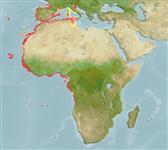Common names from other countries
Environment: milieu / climate zone / depth range / distribution range
Οικολογία
Θαλασσινό(ά) βενθικό(ς); εύρος βάθους 1 - 300 m (Ref. 27000), usually 4 - 160 m (Ref. 95541). Subtropical; 47°N - 13°S, 27°W - 42°E
Eastern Atlantic and Mediterranean Sea. Records of Epinephelus alexandrinus from Madeira are apparently based on misidentifications of Myctoperca fusca.
Length at first maturity / Μέγεθος / Βάρος / Age
Maturity: Lm 32.5, range 30 - 35 cm
Max length : 140 cm SL αρσενικό/απροσδιόριστο; (Ref. 12382)
Ραχιαίες άκανθες (συνολικά) : 11; Μαλακές ραχιαίες ακτίνες (συνολικά) : 15 - 17; Εδρικές άκανθες: 3; Μαλακές εδρικές ακτίνες: 8. Distinguished by the following characteristics: head and body brownish, fins darker; two dark lines on head, one from lower edge of the eye to the ventral rear edge of the interopercle, 2nd from the dark maxillary streak to the lower edge of the preopercle; adults brown or greyish brown; distinct yellow blotch on body below the spinous dorsal fin; body depth less than head length, depth contained 3.0-3.4 times in Sl; head length 2.5-2.7 times in SL; interorbital area convex; angular preopercle, 2-3 enlarged serrae at the angle; middle and lower opercular spines flat but distinct, upper spine not apparent; straight or slightly convex upper edge of operculum; maxilla usually reaching a vertical rear edge of eye, ventral edge of maxilla with low step, no scale on maxilla; 2 rows of teeth on midlateral part of lower jaw; lateral body scales ctenoid, with auxilliary scales in adults; pyloric caeca 17 (Ref. 89707).
Found on sand, mud or rock bottoms (Ref. 6789). Juveniles form small groups (Ref. 12382) in shallow water (Ref. 89707). Feeds on crustaceans, mollusks, and fish (Ref. 12382). Does not adapt well in aquariums (Ref. 12382). Maximum depth from Ref. 128827.
Life cycle and mating behavior
Maturities | Αναπαραγωγή | Spawnings | Egg(s) | Fecundities | Προνύμφες
Heemstra, P.C. and J.E. Randall, 1993. FAO Species Catalogue. Vol. 16. Groupers of the world (family Serranidae, subfamily Epinephelinae). An annotated and illustrated catalogue of the grouper, rockcod, hind, coral grouper and lyretail species known to date. Rome: FAO. FAO Fish. Synop. 125(16):382 p. (Ref. 5222)
IUCN Red List Status (Ref. 130435)
CITES (Ref. 128078)
Not Evaluated
Threat to humans
Harmless
Human uses
αλιεία: περιορισμένης εμπορικότητας
Εργαλεία
Warning: mysqli::__construct(): (HY000/1040): Too many connections in /var/www/html/includes/speciessummary.lib.php on line 2104
Can't connect to MySQL database fbquizv2. Errorcode: Too many connections
